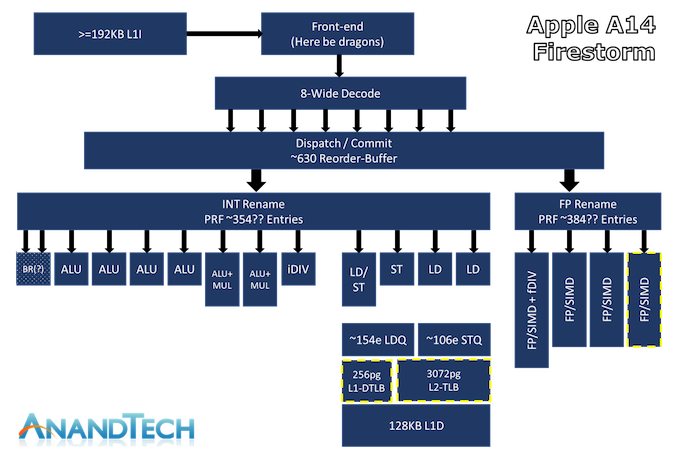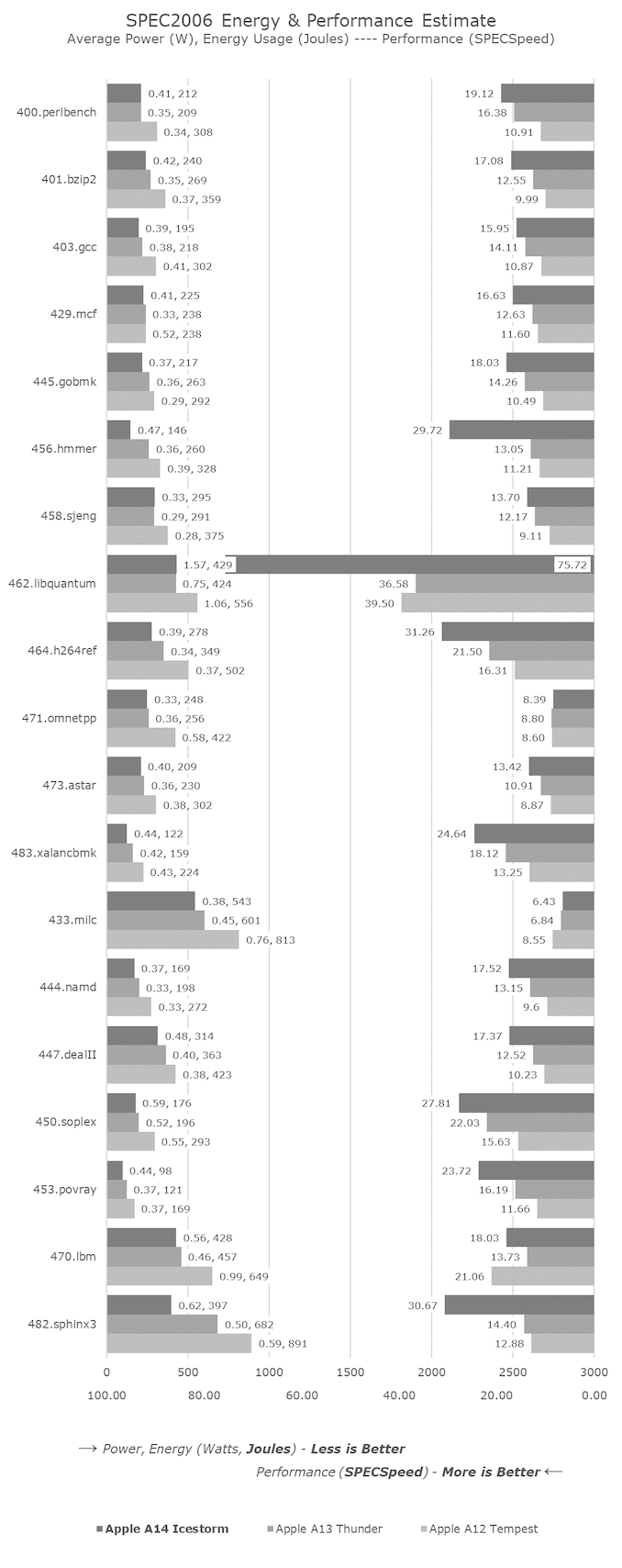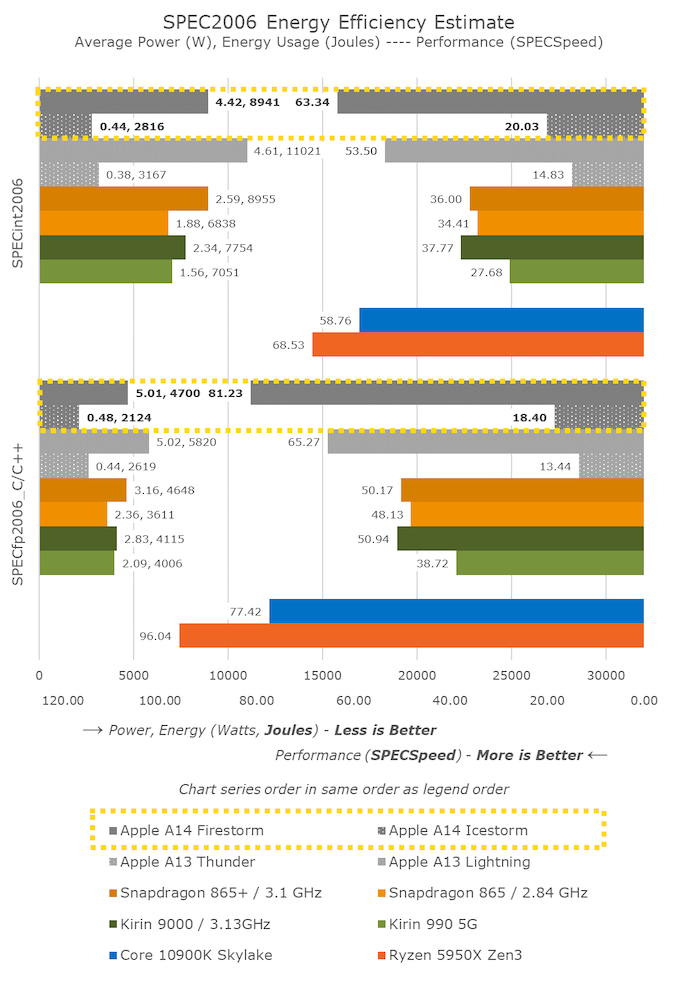The iPhone 12 & 12 Pro Review: New Design and Diminishing Returns
by Andrei Frumusanu on November 30, 2020 8:30 AM EST- Posted in
- Mobile
- Apple
- Smartphones
- Apple A14
- iPhone 12
- iPhone 12 Pro
The Apple A14 SoC: Firestorm & Icestorm
The new Apple A14 is the company’s newest mobile SoC and sits at the heart of the new iPhone 12 series. The new chip is the industry’s first commercial 5nm manufactured chip from TSMC, alongside the now no longer manufactured Kirin 9000.
Inside the A14 we find two big performance cores dubbed “Firestorm” and four efficiency cores called “Icestorm”, making this a 2+4 heterogeneous CPU SoC. Alongside the CPUs, we also find a 4-core GPU. Unfortunately this year it seems like we haven’t seen a public die shot of the A14, though Apple themselves published a shot of the M1 during their announcement event.
| Maximum Frequency vs Loaded Threads Per-Core Maximum MHz |
||||||
| Apple A13 | 1 | 2 | 3 | 4 | 5 | 6 |
| Performance 1 | 2666 | 2590 | 2590 | 2590 | 2590 | 2590 |
| Performance 2 | 2590 | 2590 | 2590 | 2590 | 2590 | |
| Efficiency 1 | 1728 | 1728 | 1728 | 1728 | ||
| Efficiency 2 | 1728 | 1728 | 1728 | |||
| Efficiency 3 | 1728 | 1728 | ||||
| Efficiency 4 | 1728 | |||||
| Apple A14 | 1 | 2 | 3 | 4 | 5 | 6 |
| Performance 1 | 2998 | 2890 | 2890 | 2890 | 2890 | 2890 |
| Performance 2 | 2890 | 2890 | 2890 | 2890 | 2890 | |
| Efficiency 1 | 1823 | 1823 | 1823 | 1823 | ||
| Efficiency 2 | 1823 | 1823 | 1823 | |||
| Efficiency 3 | 1823 | 1823 | ||||
| Efficiency 4 | 1823 | |||||
The new A14 raises the clock speeds of the CPU by a good amount, now essentially reaching 3GHz on the large performance cores in single-threaded scenarios. Once a second big cores come on this reduces to 2.89GHz and stays there even in heavier multi-threaded workloads. The efficiency cores land in at 1823MHz now, roughly a 100MHz boost over the A13, but we do know that in power unconstrained scenarios they can reach quite higher, such as 2064MHz employed on the M1.
The summary is that in this generation, Apple progresses the design further and making it wider than before, increasing the ROB size from 560 to 630, having significantly larger L1 DTLB which has now doubled in size from 128 pages to 256 pages, and increasing the L2 TLB from 2048 pages to 3072 pages. It’s particularly on the part of the floating point and vector execution units where the new Firestorm cores saw most of the design changes this year through the introduction of a 4th pipeline unit, essentially increasing the execution capabilities of this part of the design by 33%. On the integer side of the CPU, things have remained relatively the same with only minor changes, and the Firestorm cores continue on with the sale 192KB L1 I-cache and 128 L1 D-cache and 8MB of shared L2 amongst the two cores.
What we didn’t cover in more detail in the M1 piece was the new small efficiency cores. The Icestorm design is actually a quite major leap for Apple as it sees the introduction of a third integer ALU pipeline, and a full second FP/SIMD pipeline, vastly increasing the execution capabilities of this core. At this point it would be wrong to call it a “small” core anymore as it now essentially matches the big core designs from Arm from a few years ago, being similar in complexity as an A75.
Looking at the generational improvements of the efficiency cores we can see that Apple is indeed showcasing performance increases beyond that of just the increased 100MHz of the cores, with substantial upgrades across the workload spectrum.
Especially the floating-point workloads of the SPEC suite see very large improvements, exactly in the tests which are more execution heavy such as 453.povray or 482.sphinx3.
Apple still continues to limit the absolute performance of the efficiency cores when they are the only allowing the memory controller to not scale up to a higher frequency, meaning that the scores here in isolation are posting worse performance than in a normal more varied real-world scenario where the big CPU cores or the GPU would also be active, hence the scores aren’t directly comparable to other measurements we’ve made.
Overall, the new A14 is massively impressive and grows the performance gap compared to the competition. Apple has now reached higher single-threaded performance within their phone SoCs than what Intel can deliver in any of their designs, whilst only losing out to the desktop variants of AMD’s new Zen3 processors.
What’s important to note here is that Apple’s performance increase this generation did not come at a cost of increased power consumption, as the designers were able to leverage the microarchitectural improvements and the new process node – actually reaching either power parity or a small power reduction compared to the 7nm based A13. This means that the performance increases this generation also results in an energy efficiency increase for the design, with the A14 using notably less energy to complete a workload.
I’ve included the efficiency cores in the chart here to showcase that they’re not weak at all. The performance showcased here roughly matches a 2.2GHz Cortex-A76 which is essentially 4x faster than the performance of any other mobile SoC today which relies on Cortex-A55 cores, all while using roughly the same amount of system power and having 3x the power efficiency.













101 Comments
View All Comments
DejayC - Monday, November 30, 2020 - link
I find the flat edges of my iPhone 12 mini to be easier to grip on to than the curved edges of the older iPhones.FunBunny2 - Monday, November 30, 2020 - link
I was just about to post just that. could it be that short people with small hands are the only ones to complain about flat edged phones (and other things)? those for 4 edges, intelligently chamfered of course, are what give you purchased to hold on to that slippery thing.jeremyshaw - Monday, November 30, 2020 - link
I think completely flat edges work better on smaller phones. Mini, 5, 5S, 5C, etc. 4 and 4S as well. Though the 4 and 4S were "technically" flat, they did have the actual back and screen protruding enough to be a stepped approximation of a curved edge.xaneo - Saturday, December 26, 2020 - link
I'm jumping onto the flat edges bandwagon, all for it.milkywayer - Wednesday, December 2, 2020 - link
I still don't understand what makes the iPhone 12 worth ~$850 after tax compared to iPhone 11 that apples website is selling for $640~? Can someone explain?My biggest gripe with iOS is it kills my previous app pretty fast e.g. I could be watching YouTube or browsing a chrome tab but if I switch to reddit and or then whatsapp and then come back to the chrome or youtube, it'll make likely reload the entire app/page and I lose my progress.
I got tired of the small keyboard on my 2020 iphone SE and was going back and forth between picking iPhone 11 vs iPhone 12 and when I realized the 13 still has the same 4gb RAM, it was an easy decision going for the iphone 11 as both have the same display size and except for the tiny bit faster cpu which I probably wouldn't have noticed browsing chrome or reddit and the oled screen which isn't a big deal.
I couldn't justify spending almost 35-40% more for a tiny tiny upgrade.
What I would love for would be to get a bigger screen size like the pro max but apple has prices those out of my budget and most people's budgets I'd assume.
Frantisek - Friday, December 4, 2020 - link
I guess very durable screen on 12 can pay for itself.Speedfriend - Sunday, December 6, 2020 - link
Your point about iOS is one of the main reasons I don't use an iPhone. I day trade and iOS suspending apps in the background means that I have switched quickly to a trading app to check prices not realising they are totally out of date. Totally uselessblackcrayon - Thursday, December 10, 2020 - link
That sounds like that particular app doesn't work properly. Apps can refresh in the background, but even if not, why would it take more than a second to update from waking a suspended app?ZGamer - Monday, December 7, 2020 - link
12 Pro models ship with 6GB ram vs 4GB.As with everything it depends on which models your looking and how your looking to buy. If looking at purchasing outright for some of the mvno carriers or prepaid service the 11 is a better deal. If looking at deals with bill pay credits and other incentives it can be very cheap to get a 12.
Sales around Black Friday had the iPhone 12 for free with qualifying trade and bill pay credits....12 Pro for $99 and 12 Pro Max for $199 if you had the right set of circumstances (new line/port-in only for AT&T and Best Buy).
In general year or year performance gains are generally pretty small, it's the two to five year old devices that can see larger performance improvements.....and a fresh battery.
ebernet - Wednesday, December 9, 2020 - link
@milkywayer these are some of the reasons that would lead me to pick a 12 over an 11...1. The iPhone 11 is an LCD screen instead of OLED, with a 2x Retina display and 1792‑by‑828‑pixel resolution at 326 ppi. The 12 is OLED with a 3 pixel per point for 2532-by-1170-pixel resolution at 460 ppi. The OLED allows the screen to be closer to the edge. I would think that is the biggest reason.
2. Significantly better night mode
3. Only 32% more, not 35-40
There are a bunch of other reasons to choose the 12 over the 11, but for me the change from LCD to OLED at MUCH higher pixel resolution and a more durable screen is sufficient.
That being said, I am still on my XS Max and will be waiting for the 13. There were days when I would upgrade my iPhone EVERY year (original all the way through the 4S). As the curve of improvements slowed down I went to every other year (5S, 6S Plus). Now I am on a 3 year tick and the XS Max is plenty good enough for me. I am looking forward to HOPEFULLY some kind of better optical zoom in the iPhone 13. However, if this was my tock year I'd be going for a 12 Pro Max with 256, but if I had to choose between an 11 and a 12 it would be a NO brainer, much more than last year choosing between the 11 and the XR (much more of a valid comparison because they both shared very similar screens). The screen on the 12 is on its own worth the price delta between the 12 and 11.